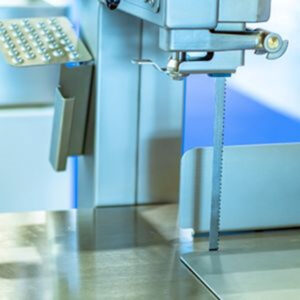 If you’re a fabricator working with plastic for the first time, it’s important to understand how this material differs from wood and metal. Cutting plastic using techniques for other materials can result in chipping or melting your workpiece. Read on to discover what you need to know about cutting plastic on a bandsaw.
If you’re a fabricator working with plastic for the first time, it’s important to understand how this material differs from wood and metal. Cutting plastic using techniques for other materials can result in chipping or melting your workpiece. Read on to discover what you need to know about cutting plastic on a bandsaw.
Use the Right Blade
Many bandsaw blade manufacturers make specially designed blades for cutting plastic. If you intend to start working with plastic regularly, you should invest in a few of these blades. However, if you’re only going to be cutting plastic occasionally, just be sure to choose a blade with a strong offset. Thin blades are also good choices because they don’t generate as much excess heat.
Check Plastic Machining Guidelines
Machining guidelines tell you vital information for working on different types of material. While you may be familiar with the guidelines for cutting wood and metal, know that plastics have their own guidelines. This is one reason why your bandsaw tooth pattern is important. Machining guidelines can include the following information:
- Recommended blade TPI (teeth per inch)
- Rake angle
- Cutting speed
- Pitch
- Clearance angle
Understand Plastic Fabrication Flaws
It’s possible to ruin just about any type of material you’re working on if you don’t know what you’re doing. For plastics and acrylics, the biggest dangers are chipping and melting. If you feed your workpiece through the bandsaw too quickly, you could end up chipping off parts of the plastic. However, feed too slowly, and enough friction might build up to melt the plastic.
Cut Thin Plastics
Another thing to know about cutting plastic on a bandsaw is that thin plastics take some special treatment to cut properly because of how flexible and lightweight they are. Without extra support, thin plastics will bounce and vibrate on the worktable, creating an uneven cutting line. To mitigate this problem, place your plastic between pieces of plywood to hold it steady.
Adding the ability to fabricate with plastics can drastically increase the versatility of your workshop. Use these tips to start working with plastics today!
About Dan Coconate
Dan Coconate is a local Chicagoland freelance writer who has been in the industry since graduating from college in 2019. He currently lives in the Chicagoland area where he is pursuing his multiple interests in journalism.







